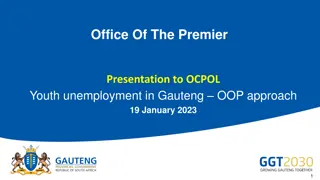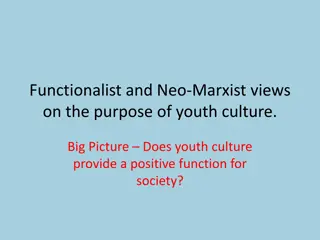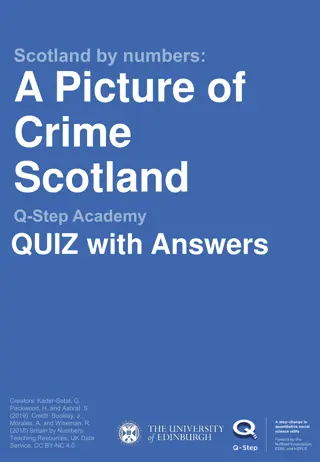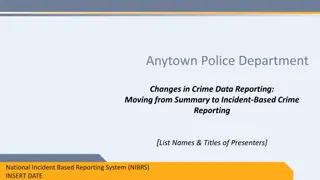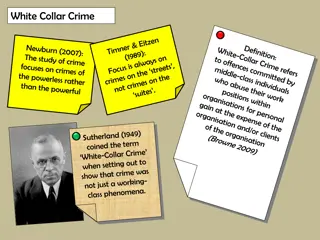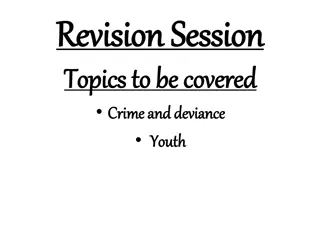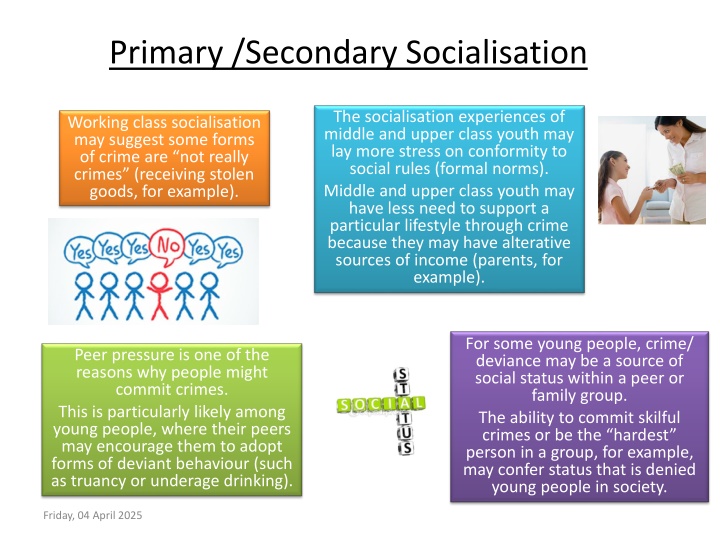
Socialisation Experiences and Crime Among Youth
Exploring how socialisation experiences differ for middle/upper class and working class youth, impacting their likelihood of engaging in deviant behaviors. Factors like social status, peer pressure, and law enforcement practices play crucial roles in shaping youth crime patterns.
Download Presentation

Please find below an Image/Link to download the presentation.
The content on the website is provided AS IS for your information and personal use only. It may not be sold, licensed, or shared on other websites without obtaining consent from the author. If you encounter any issues during the download, it is possible that the publisher has removed the file from their server.
You are allowed to download the files provided on this website for personal or commercial use, subject to the condition that they are used lawfully. All files are the property of their respective owners.
The content on the website is provided AS IS for your information and personal use only. It may not be sold, licensed, or shared on other websites without obtaining consent from the author.
E N D
Presentation Transcript
Primary /Secondary Socialisation The socialisation experiences of middle and upper class youth may lay more stress on conformity to social rules (formal norms). Middle and upper class youth may have less need to support a particular lifestyle through crime because they may have alterative sources of income (parents, for example). Working class socialisation may suggest some forms of crime are not really crimes (receiving stolen goods, for example). For some young people, crime/ deviance may be a source of social status within a peer or family group. The ability to commit skilful crimes or be the hardest person in a group, for example, may confer status that is denied young people in society. Peer pressure is one of the reasons why people might commit crimes. This is particularly likely among young people, where their peers may encourage them to adopt forms of deviant behaviour (such as truancy or underage drinking). Friday, 04 April 2025
Social Control Agencies If opportunities for deviance are denied, then crime cannot occur. For example, young women are given less freedom by their families than young men which means they will have fewer opportunities to commit crimes. Risk-taking and thumbing their nose at authority may be characteristics of the young which are more-likely to lead them into crime. Friday, 04 April 2025
Labelling by the police Just like everyone else, the police have an ideological conception of both crime and criminals (ideas about who is most likely to commit certain types of crime). They use this mental map as a guide for their work. As the young males are associated with crime this becomes a self- fulfilling prophecy. Also, the police focus on young males and therefore it is more likely that any involvement in crime is picked-up. Young people have less status in our society which may lead the police to police their behaviour more closely / heavily. Friday, 04 April 2025
Labelling by the courts Young people have fewer social responsibilities which means any conviction / imprisonment will have less impact on others (such as young children). Are young, working class, men stereotyped as real criminals whereas older middle class women may escape such stereotyping? Young people (especially working class) are less-likely to be able to afford expensive legal representation. Friday, 04 April 2025
Social Visibility Large amounts of petty youth crimes take place in public places (clubs, the street, etc.) where deviance is more-likely to be witnessed. Most violent crime that isn t murder or domestic violence is likely to committed by young people in situations involving drink, drugs, clear victims and witnesses. Much youth crime is unsophisticated and unplanned. It is, therefore, more-likely to be witnessed than more-sophisticated crimes. An older person committing a tax fraud may be socially invisible. Friday, 04 April 2025
Lifestyle Factors The lifestyles of young people (the young are the most-frequent users of pubs and clubs for example) may expose them to situations where criminal behaviour is possible / likely. Young people are more-likely to be involved in public drinking, clubbing, etc. may simply mean they are more-likely than the elderly to find themselves in an environment that encourages criminal activity. Friday, 04 April 2025








